
 FIRE IN 1939 LEVELED PART OF DOWNTOWN IBERIAFrom the Miller County Autogram-Sentinel, May 16, 1985
On April 22, 1939, late on a Saturday evening in the balmy, windy season of mid-springtime, the village of Iberia (population 535) experienced her most devastating fire in the town's history. Jimmie Eads, driving a gasoline tank truck, was filling an underground fuel tank in front of the Lev Adams Produce Co. on St. Louis Street. While the tank was being filled, one of the town's young men came along and struck a match on the metal elbow of the hose to light his cigarette, unaware of the impending danger. The fumes from the tank were ignited and started the disastrous blaze. In the excitement and confusion following, if proper judgments had been used, perhaps the fire could have been extinguished there, but in times of disaster, one's reaction is completely unpredictable. One of the produce company's employees grabbed the hose and removed it from the truck, spewing the liquid fuel all over the front of the wooden building. In an instant the whole front of the produce store was engulfed in flames. Everything in the building was destroyed including the company's books and money. Alfro "Alf" Eads, father of Jimmie, rushed to the scene, shut off the gasoline at the tank, jumped in the cab, and drove the truck, all ablaze, away from the burning building and eastward on Highway 42 and out of town. The flames spewing from the truck were extinguished in the flight of the truck driven by Mr. Eads-a very heroic deed in face of such danger! 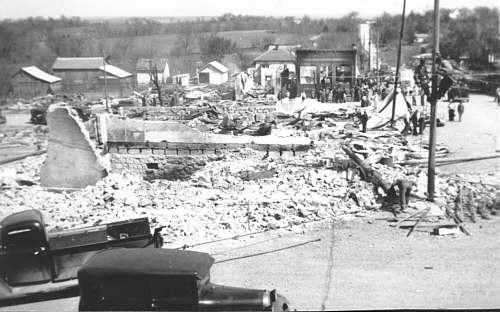 The brick building to the right of center is the one and only bank Iberia had. The vault can be seen in the back left hand corner of the building. At the back of the bank on Main Street, a garage and dentist’s office burned. The produce company, which had been in existence only two years, was a large frame structure and it burned very quickly. The flames spread to the Arthur Jones Garage occupied by the Harry McGill Truck Lines and onward to the Brouse Dickerson two-story building adjoining. The fire spread back to the Irwin and Perkins Garage with an office and supplies building adjoining; the Clarence L. Casey office building (formerly was the von Gremp office building) occupied by Dr. E.D. Suggett; and the Bank of Iberia, a one-story structure located on the corner of the block. (This building had been built circa 1924. The old one was moved to Lombar Ave. which is occupied today by Catron's Electric Shop.) Had not the wind suddenly shifted, the entire residential district east of the bank would have burned. A brisk wind from the southeast carried the wall of fire across St. Louis Street and enveloped the George Adams and Clarence Casey Mercantile Co., a large frame building with a funeral home occupying the second floor. 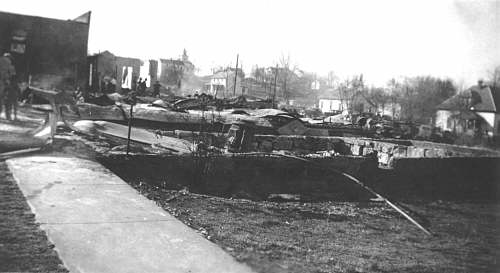 The first building is the dentist’s office and the garage is above that. The steeple of the Baptist Church can be seen in the distance. Practically all the glass fronts of the business houses no Main Street facing the fire, were broken. The Nixdorf building caught fire a couple of times from the intense heat, but a well-organized bucket brigade of town residents, located in an upstairs window, kept the building saturated and finally saved the scorched, weatherboard building. From the Adams and Casey Store, the flames continued on their path of destruction westward in the block. Destroyed was the old Rowden Hotel owned by Mrs. Cliff Clark and occupied by the Oscar Wilson Restaurant on the first floor with rental rooms upstairs and it also housed the W.P.A. Sewing Room. The old Rowden residence at the rear of the hotel, owned by Arthur Jones, was occupied by the Lee Atwell family and it was destroyed, as was a large, two-story structure also built by Arthur Jones, occupied by the Loren Atwill family. A home owned by Melvin Perkins was destroyed and a building occupied by Hedges Beauty Shop was also a loss. Next in line was the M.E. Kinder's new private garage and the two-story concrete building with Kinder's Restaurant and meat market inside, on the corner of the block where the concrete walls finally stopped the hungry flames. Had not these strong concrete walls held back the fire, then without any doubt, the Groff building, the Clark residence (present home of Leftie Kinder), Farnham's Store and Lumberyard, the old Shelton Hotel and post office would have been leveled by the flames. 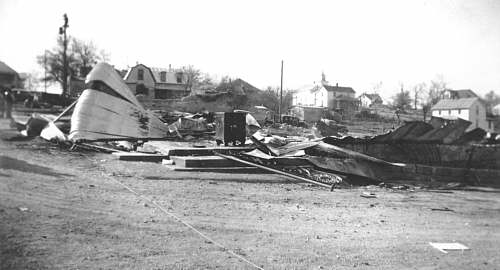 Main Street—Adams & Casey Store with their safe on the front porch. The white house at extreme right was the home of Josephine Shockley Blankenship. Black smoke could be seen billowing high in the skies and was seen for a 25-miles radius of the town. Hundreds of people witnessed this distressing spectacle from various vantage points. I can only vaguely remember the soaring flames, the excitement; the milling crowds. My family was living in a small house to the west of the Baptist Church and we stood on the hillside and watched as the flames literally swallowed up the town. In all, 14 buildings were burned covering practically two business blocks, and only a small portion of theses buildings were covered with insurance due to the fact that so many were wooden structures, constructed very close together, making them a fire hazard and the insurance rates were exorbitant even in 1939. The three heaviest losses were incurred by Adams & Casey who had approximately $16,000 stock in merchandise and funeral supplies; Lev Adams' Produce, with a loss of approximately $4,000; and M.E. Kinder's Restaurant and living quarters with a loss of about $4,000. The Eldon Fire Department, 28 miles north, was called for assistance, but the fire call was too late. Evidently there were some communication problems. Eldon's fire chief, M.E. Atkinson, stated in a newspaper report, "before we could get out of the city, a second call came through stating that the crest of the conflagration had somewhat subsided and there would be no need of coming". I doubt that the fire department could have saved even one building had they driven the 28 miles. The town was in total darkness that Saturday night because the light and power systems were put out of commission by the fire. Local merchants reported they had complete sell-outs of lamps and lanterns and the entire town reverted back to the days of candlelight and kerosene lamps. When word spread about Iberia's big fire, curiosity spread over the country and the next two or three days, sightseers swarmed into the area. It was reported folks came in from St. Louis, Kansas City, Sedalia, Jefferson City, Rolla and many other towns, giving Iberia's surviving cafes a booming business! Did Iberia die after her holocaust of fire? Indeed not! The people began a rebuilding project. Some businesses were transferred to temporary quarters, but eventually a new town arose from the ashes, much like the legendary "Phoenix" and took on new life. The citizens pulled together for a greater and better Iberia. They did not bend to defeat after the calamity because it was a thankful community who realized they were so very fortunate to have suffered no loss of life in the great fire nor any injuries. A local newsman said in 1939…"These Iberians are men of stamina who have the determination to carry on. Knowing them as we do, we are led to believe that, despite the gloom, they see a silver lining beneath the cloud. We vision, as many others do, a rebuilt district with buildings more attractive and substantial. We are populated by fine and enterprising people with high standard and the reputation of our educational institutions alone are enough to assure an abiding faith in the future welfare of the community." History almost repeated itself because in 1941, another gasoline fire broke out at the same location-the Adams Produce Exchange! An employee of the Exchange was filling the tank of a gasoline engine, which operated a hammermill inside the main building and it burst into flame. The tank had run dry and while trying to refill it from a five gallon can, the heat from the exhaust pipe ignited the gasoline in the tank and the can. The employee, Elbert Condra, was badly burned on his arms, hands and face. The flames were extinguished with the help of another employee, Paul Ponder. Iberians, both former and present, should be grateful that Iberia is a town that has proven to be a "survivor." She still has much history that can be written, and if not I, then someone else who will follow me, can record the important stories. 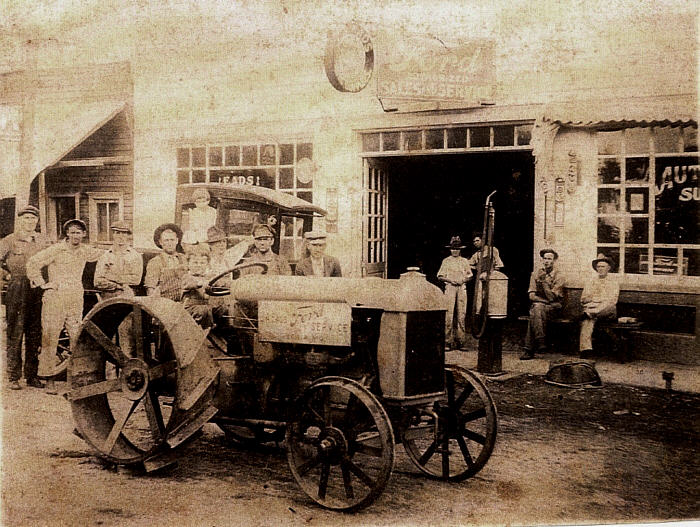 Eads Garage - Iberia This photo was taken in front of Eads Garage around 1915. Pictured from left-right: Harry Lovell, Emery Robertson, Everett Wilson, Luther Dickerson, Everett Malmberg, unknown, J.A. Eads. Ford Eads is on the tractor and an Eads girl is in the truck. In the doorway: Gerald Gardner and Clarence Driver. Seated on bench: Ray Casey and Clint Condra. 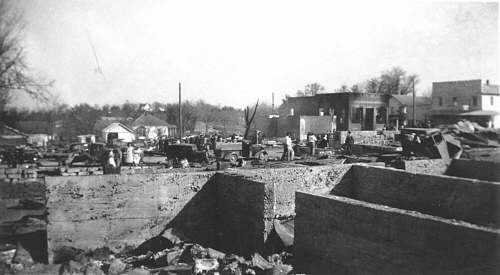 The front foundation is what remained of Loren Atwell’s home. The old truck at the back of the building also burned—the man’s wife got excited and couldn’t find the keys to the truck. The foundation at left is what remained of the residence of Lee Atwell. |
||

|
P.O. Box 57 Tuscumbia, MO 65082 http://www.MillerCountyMuseum.org © 2007 - Miller County Historical Society |

|